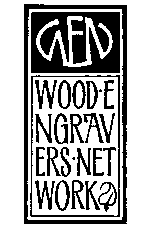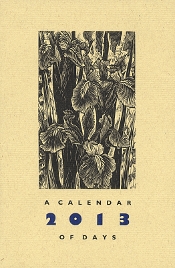The Porcupine's Quill
Celebrating forty years on the Main Street
of Erin Village, Wellington County
BOOKS IN PRINT
A Calendar of Days by The Wood Engravers' Network
A Calendar of Days (2013) is the second in an on-going collaboration between the Wood Engravers’ Network (WEN) which includes members from the United States, the United Kingdom, Europe and Asia as well as Canada, and a small, but distinguished Canadian literary press, the Porcupine’s Quill (PQL) which has long been recognized for its interest in the reproduction of wood engravings and its technical expertise in creating affordable offset presentations for dissemination, worldwide.

A Calendar of Days includes fifteen reproductions of prints of wood engravings contributed by a variety of artists. The images have been proofed letterpress in the traditional manner, then digitized and printed offset at the shop in Wellington County. Contributors include Wesley W. Bates, Gerard Brender à Brandis, Tony Drehfal, Colleen Dwire, Leslie Evans, Judith Jaidinger, Rosemary Kilbourn, John McWilliams, Gale Mueller, Sylvia Pixley, Michelle Post, Keri Safranski, Richard Wagener, Jim Westergard and Richard Woodman.
Description for reader
The progress of human civilization created a demand for information. Johannes Gutenberg’s innovation in the use of movable type (ca 1439) was a significant step in that evolution. At about the same time there also emerged a need to reproduce images. To meet the challenge, wood became the first medium of choice for printmaking.
The earliest known European woodcut is the St. Christopher, dated 1423. Typical subjects were often religious and used as souvenirs of pilgrimages to the shrines of saints. The Germans, notably Albrecht Dürer (1471-1528) and the Formschneider block cutters, raised the practice of woodcutting to a fine art.
The sixteenth and seventeenth centuries saw woodcut decline to a crude manner, often used in what were called ‘Chapbooks’. They were popular with the common people, and provided an effective means of illustrating fables and the rudimentary journalism of the time.
Thomas Bewick (1753-1828) refined the use of the medium as an end-grain process to its fullest potential. His small vignettes, often illustrations of birds and animals, are recognized as masterpieces of engraving. Bewick’s many apprentices spread the craft throughout England, and led to the Victorian appetite for fine illustration. In America, a physician, Alexander Anderson (1775-1870) brought the craft to a fine art in the New World.
The practice of wood engraving was well suited to newspaper, book and periodical illustration. It was the only printing medium that could be simultaneously inked with type as text. It also became prevalent in commercial graphics. The publication in 1842 of The Illustrated London News, for example, attracted worldwide attention and demand. The beauty and excellence of the engravings were unsurpassed in the history of art, as images which captured the spirit of the human drama. Copies of the engravings were often cast in metal for duplication. These duplicates, called stereotypes, could be dispatched simultaneously throughout the world for journalistic purposes.
Engravers were also active in America. Publications such as Leslie’s Popular Monthly, Harpers, Scribner’s and The Century Magazine featured the work of famed Timothy Cole and the leading engravers of the day. Examine a wood engraving with magnification. You will see the tool marks rendered as fine lines as opposed to the dots of a halftone required by photographic processes. Frequently the engraver signed his name to the block and added an ‘SC’ which stood for sculptor.
Photographic processes eventually supplanted the use of wood engraving for industrial use, although engraving retained a niche in the commercial field well into the twentieth century, especially for catalogue illustration. What did evolve, however, was the use of wood engraving as a fine art. The turn of the nineteenth century saw the era of private presses embrace wood engraving once more for fine book illustration and limited edition prints. That tradition continues today.
—Jim Horton
Biographical note
Wesley W. Bates studied painting and printmaking at Mount Allison University. His engravings are held in public and private collections in China, Spain, Japan, England, the US and Canada. He lives in Clifford, Ontario.
Gerard Brender à Brandis’ career in wood engraving spans forty-five years. Many of his images are conceived as part of his handmade artist’s books. His studio is located in Stratford, Ontario.
Tony Drehfal graduated in Fine Arts from the University of Wisconsin-Milwaukee. Inspired by the landscape around his Wisconsin home, he uses wood engraving to portray the intricate detail of the natural world. Tony is an active member of the Wood Engravers’ Network.
After studying printmaking at UC Berkeley, Colleen Dwire was introduced to wood engraving tools and techniques in a workshop given by John DePol. Colleen enjoys illustrating and has been a member of WEN since 1994.
Leslie Evans graduated with a BFA in printmaking from Rhode Island School of Design. In 1980 Leslie established her letterpress studio, Sea Dog Press, where she prints art for her illustration business and publishes posters, cards and limited edition prints.
Judith Jaidinger received her BFA from the School of the Art Institute of Chicago. She has participated in exhibitions since 1966. Her prints are held by galleries across the US. She is a member of the Society of Wood Engravers.
After art college, Rosemary Kilbourn taught herself engraving by illustrating three books. Enjoying the direct simplicity, she began creating much larger prints than are typical for engraving. She is a member of the Royal Canadian Academy and the Society of Wood Engravers.
John McWilliams has worked as a photographer, artist and educator. In 2003 he was the Director of the Ernest G. Welch School of Art and Design in Atlanta. John’s studio is in McClellanville, SC, where he primarily works in relief printmaking and drawing.
Motivated by a desire to produce Christmas cards, Gale Mueller has been a hobby letterpress printer for over fifty years. Linoleum blocks and woodcuts were used for early images, but wood engraving has been the preferred medium since the 1980s. Gale is a member of WEN.
After she bought a kit and instruction book from David Sanders in 1977, Sylvia Pixley has been making wood engravings. She sells her prints at art fairs throughout the eastern half of the United States. Sylvia is an original member of WEN.
Michelle Post apprenticed with renowned wood engraver Stefan Martin in 1976. In addition to wood engraving, she enjoys linocuts and reduction linocuts. Her highly detailed work in printmaking led to sculpture which is now her main artistic focus. ‘Le Corbeau’ is a wood engraving of her bronze piece ‘On Guard’.
Keri Safranski has been creating wood engravings since 1984. She has shown her prints in numerous galleries across North America and has been a member of WEN since 1995. Keri lives in West Lafayette, Indiana.
Richard Wagener is the artist/author of Zebra Noise with a Flatted Seventh (Peter Koch Printers, 1998), Cracked Sidewalks (Mixolydian Editions, 2006), California in Relief (Book Club of California, 2009) and Mountains & Religion (Mixolydian Editions, 2011). He works and lives in northern California.
Jim Westergard lives in Red Deer, Alberta where he works out of his studio. After an MFA in printmaking he began teaching at colleges and universities in Colorado, Illinois, and finally at Red Deer College in Alberta. He’s been a Canadian citizen since 1980 and retired from teaching since 1999.
Richard Woodman is the inventor of Resingrave, a more affordable alternative to end grain boxwood, which Barry Moser used for his wood engravings in the 1999 Pennyroyal Caxton Bible. Richard’s favourite source of inspiration is a genre style of illustration from the recent past.
Description for teachers/educators
Wood engraving is a relief printmaking process. The raised surface of the engraved block receives ink from a roller and prints directly onto paper. Other, related, printing processes include planography and lithography, which are both based on the repulsion of oil and water on a flat surface; intaglio, which involves cutting into the surface of a metal plate (in which case the lowered surface holds the ink); and stencil methods such as silk screen.
Wood engraving is a subtractive technique in which fibers are removed with sharpened burins from the end-grain of a wood block. Wood engraving should be differentiated from woodcut, in which the tool works on the cross grain, or plank-side of a wood block. Wood engraving allows for a much wider variety of cutting techniques and is also extremely durable on a printing press. For this reason the medium lends itself well to illustration as well as to limited edition printmaking. Wood engraving has a most interesting history of usage as well as an enthusiastic contemporary community of practitioners.
The Wood Engravers’ Network (WEN) was formed in 1994 by a group of American printmakers with a particular interest in wood engraving. The group facilitates communication, encouragement and education in this historic, yet contemporary relief medium. One such activity is the publication of a biannual newsletter called Block & Burin which features articles, events, news and announcements of interest to the community. The Wood Engravers’ Network currently supports over two hundred members from the US, the UK, Canada, Europe and Asia. The group maintains a lending library and publishes a resource catalogue which directs artists to the best places to source tools and materials and it also organizes yearly workshops.
The Porcupine's Quill would like to acknowledge the support of the Ontario Arts Council and the Canada Council for the Arts for our publishing program. The financial support of the Government of Canada through the Canada Book Fund (CBF) is also gratefully acknowledged.






